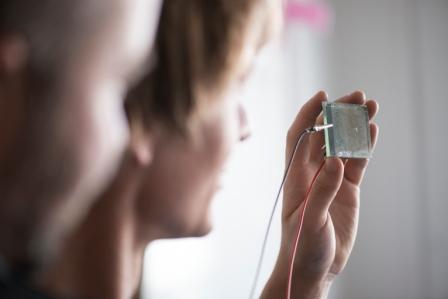16.01.2015
A research team from the University of Kassel recently developed a building material that simultaneously functions as a photovoltaic cell. Important components of this new material are electrographic concrete and liquids such as fruit juices. In the future, “DysCrete” is supposed to be used for the construction of façades and at the same time transform solar energy into electric power.
“DysCrete” consists of a special, electrographic concrete, which is coated with layers of titanium dioxide, organic liquid, an electrolyte, graphite, and a transparent surface. The result of that combination is a dye-sensitized solar cell and the concrete assumes the function of an electrode. The transformation of solar energy into electric power follows the principles of photosynthesis and the material is especially ecofriendly.
The development of „DysCrete“ is a project of the interdisciplinary learning and researching platform „Bau Kunst Erfinden“ (“Building Art Invention”), led by Prof. Heike Klussmann, Head of Visual Art Studies at the University of Kassel, and Thorsten Klooster, project manager of the field. The project received funding of approximately Euro 150,000 from the Federal Ministry for Housing and Development and will continue into the middle of 2015. Partners in this project are the field of Materials of the Building Industry and Construction Chemistry (Head Prof. Dr. Bernhard Middendorf) and other associates from the industry.
Prototypes of the solar energy concrete are already in existence. “It is our goal to develop a material that can be employed in the construction industry in the future, e.g. for prefabricated components for building construction, façade elements, and innovative wall systems,” explains Prof. Klussmann. “At the same time, it will contribute to a sustainable and decentralized energy supply through its function as a solar cell.”
The dye-sensitized solar cell itself is not an invention of the University of Kassel. What makes this development so novel, however, is the conflation of solar cell and construction material. The dye-sensitized solar cell or “Grätzel Cell” is an affordable alternative to the conventional silicon solar cell and was developed by the Swiss chemist Michael Grätzel utilizing the principles of photosynthesis in plants.
To achieve the best possible efficiency when transforming solar energy with the solar energy concrete, the group around Prof. Klussmann and Prof. Klooster is currently optimizing the coatings. For example, while in the beginning of the project the researchers used currant juice, they are now employing other fluids. The team is aiming for an efficiency of approximately two percent. “This is profitable because the manufacturing costs for dye-sensitized solar cells are significantly lower than the cost for silicon solar cells,” says Klooster. Moreover, the components for dye-sensitized solar cells are readily available, ecofriendly, and easily recycled. Titanium dioxide, for example, is often used and can also be found in toothpaste. Also, dye-sensitized solar cells and thus “DysCrete” react to diffused light and can therefore be used for the northern face of buildings. “Bau Kunst Erfinden” will present “DysCrete” and other innovations at the BAU 2015, the world’s leading trade show for architecture, materials, and systems, which takes place from January 19-25, 2015, in Munich.
For more information, please visit www.baukunsterfinden.org















